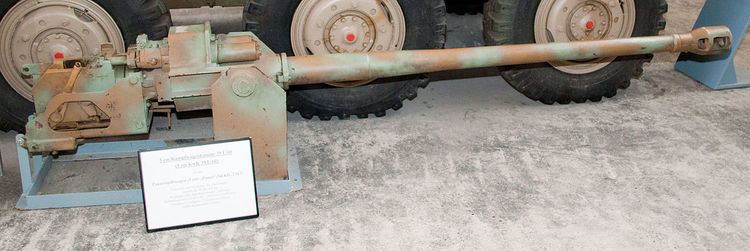 | ||
The 5 cm KwK 39 L/60 (5 cm Kampfwagenkanone 39 L/60) was a German 5 cm calibre gun used during the Second World War, primarily as the main armament of later models of the German Panzerkampfwagen III tank from 1941 onwards. It was produced when the well-armoured T-34 and KV-1 tanks were encountered in ever increasing numbers on the Eastern Front, although it was only partially successful in its role. It was later superseded by the 7.5 cm KwK 40 L/43.
Contents
It was also mounted on the SdKfz 234/2 Puma armoured car.
History
It was developed as a variant of the 5 cm Pak 38 towed anti-tank gun. On the Panzer III, it replaced the 5 cm KwK 38, which had an L/42 calibre length and a lower muzzle velocity. However, even the 5 cm KwK 39 gun with a longer barrel, higher muzzle velocity and more penetration was not sufficient against newer Soviet T-34 and KV-1 tanks. Therefore, as time went on, the Panzer III was no longer effective as a medium tank that could engage in fights with enemy tanks. So, a new role for the Panzer III tank was found. On the Panzer III, the 5 cm KwK 39 was phased out in favor of the shorter but larger calibre 7.5 cm KwK 37 L/24 low velocity guns that could fire more effective HE and HEAT rounds. HE howitzer type rounds with explosive forces and shrapnel were very effective against infantry, machine gun nests and towed enemy guns on the battlefield. However, early HEAT rounds were somewhat unreliable. They were useful against hardened fortifications and had a good, though limited, capability against enemy armour. Thus, they were used against enemy tanks mostly in an emergency. With these changes, the Panzer III with the 7.5 cm KwK became an infantry support tank late in its career, while the new, much more capable 7.5 cm KwK 40 L/43 was mounted on the larger Panzer IV Ausf. F2 (and the longer L/48 on subsequent Ausf. versions) to fight the KV and T-34 tanks.
Ammunition
Average penetration performance established against rolled homogenous steel armour plate laid back at 30° from the vertical.
PzGr. 40 (Armour-piercing, composite, rigid)
Vehicles mounted on
Aerial version
Bordkanone-series BK 5 heavy-caliber autocannon
